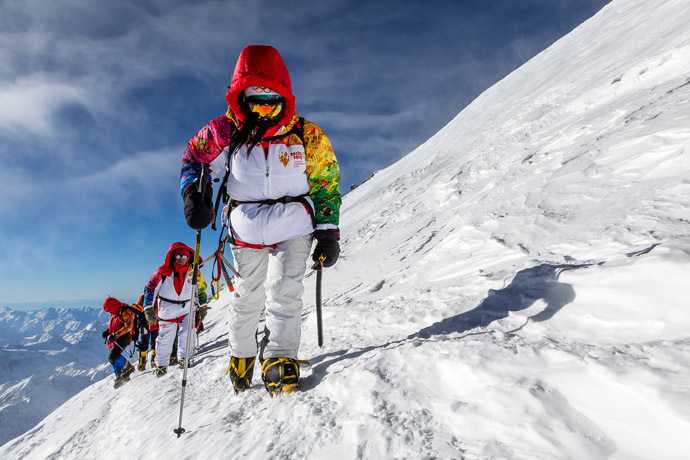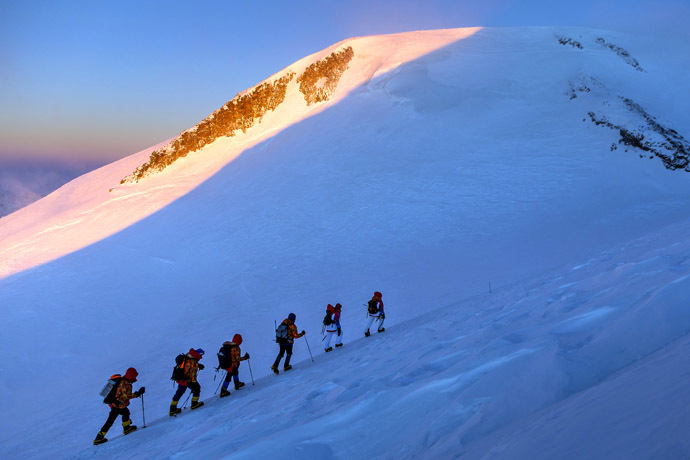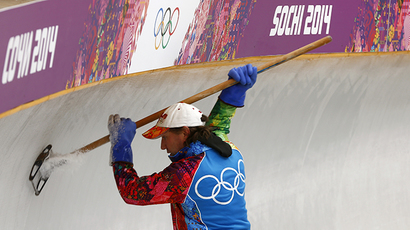Mount Elbrus reconquered: Olympic Flame reaches Europe's highest point (PHOTOS)
With the Winter Olympic Games in Sochi just round the corner, the Olympic Flame has been lit at the summit of the highest point in Europe, Mount Elbrus, which lies in the Greater Caucasus mountain range.
During the relay, the longest in Olympic history, the Olympic torch has been seen at the International Space Station, in outer space, on the bottom of Lake Baikal, at the main Buddhist temple and monastery in the Republic of Buryatia, on top of Avachinsky volcano on the Kamchatka Peninsula, and at the North Pole.
A team of five experienced mountaineers has also reached the summit of Mount Elbrus with the Olympic Flame in a special lantern, the Torch Relay Committee revealed on Saturday.
Although commonly known as a mountain, Mount Elbrus is in fact a layered volcano, which last erupted about 2,000 years ago. It has long been a challenge for climbers from across the world, with the first documented ascent of the eastern summit in 1829. The slightly higher western peak was first conquered in 1874.

The plan to take the Olympic Flame to the western peak of Elbrus, at an altitude of 5,642 meters above sea level, was developed separately from the main Olympic Torch Relay route to have a chance to choose the best possible weather conditions for the climb.
At the end of October 2013, a Russian team of mountain climbers made an ascent of the western summit of Elbrus. One of the mountaineers, Karina Mezova, has climbed to the summit of Elbrus 130 times; the other, the president of the Climbing Federation of the Republic of Kabardino-Balkaria, Abdul-Khalim Elmezov, has climbed Elbrus more than 220 times.

The 2014 Winter Olympics torch relay kicked off October 7. Its epic 123-day journey across Russia is set to reach its climax Friday, at the highly-anticipated Sochi Winter Olympics opening ceremony during which the Olympic cauldron at Sochi’s Fisht Olympic Stadium will be lit with the historic torch that has once traveled to the International Space Station.
The record-breaking 65,000-kilometer Olympic Torch Relay route is 1.5 times longer than the Equator: the distance it covers equals 26 flights between Moscow and London, or eight flights between Moscow and Vancouver.
The course of the journey has been masterminded in a way to ensure that the majority of Russians at some point could have a chance to be within an hour of the Relay, allowing up to 130 million residents to take part in the event.

A total of 14,000 torch bearers have taken part in the 2014 Olympic Torch Relay, with the oldest participant aged 101. Meanwhile, the average pace of the Olympic Torch Relay is 534 kilometers a day, with a variety of means of transportation available to ship it, including the traditional Russian three-horse sled, the troika, dog sled and reindeer sled, a hot air balloon, an amphibious motorboat, a medieval “ladya” Russian sailboat, a motorbike, a water scooter, a wakeboard, a ski bike, a snowmobile, as well as a snow-and-swamp buggy, just to name a few.
The 2014 Olympic Torch Relay has been hosted by 135 cities located in all of Russia’s 83 federal subjects. The longest nonstop leg of the relay spanned 2,055 kilometers, between the cities of Norilsk and Yakutsk in the Russian Far East.














